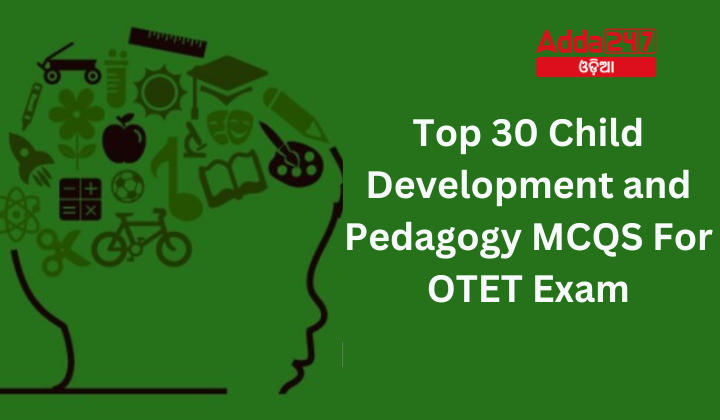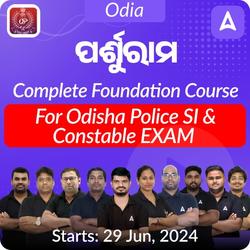The Odisha Teacher Eligibility Test (OTET) assesses the eligibility of candidates to teach in schools of Odisha. A crucial section of this exam is Child Development and Pedagogy, which evaluates understanding of child development and the principles of pedagogy. Below are 30 multiple-choice questions (MCQs) designed to help candidates prepare for this section.
Top 30 Child Development and Pedagogy MCQS For OTET Exam
- What is the most accurate definition of learning?
A) A temporary change in behavior due to experience
B) A permanent change in behavior due to growth
C) A relatively permanent change in behavior due to practice and experience
D) A temporary change in behavior due to maturation
Answer: C) A relatively permanent change in behavior due to practice and experience - Which type of learning involves higher-order mental processes like thinking and reasoning?
A) Motor learning
B) Verbal learning
C) Concept learning
D) Discrimination learning
Answer: C) Concept learning - Thorndike’s theory of learning is known as:
A) Classical conditioning
B) Operant conditioning
C) Insight learning
D) Trial and error learning
Answer: D) Trial and error learning - In Pavlov’s classical conditioning experiment, what is the unconditioned stimulus (UCS)?
A) Bell
B) Food
C) Saliva
D) Light
Answer: B) Food - Skinner’s box is most closely associated with which learning theory?
A) Classical conditioning
B) Operant conditioning
C) Insight learning
D) Observational learning
Answer: B) Operant conditioning - Which of the following is a sub-principle of classical conditioning that explains the cessation of a response when the conditioned stimulus is repeatedly presented alone?
A) Generalization
B) Discrimination
C) Extinction
D) Higher order conditioning
Answer: C) Extinction - According to the law of readiness by Thorndike, which statement is true?
A) Repeated exercising of a response strengthens its connection with the stimulus.
B) The organism is motivated to respond when ready.
C) Responses followed by satisfying consequences are more likely to be repeated.
D) Mental set or positive attitude is essential for learning.
Answer: B) The organism is motivated to respond when ready. - Kohler’s experiment with Sultan the chimpanzee demonstrated which type of learning?
A) Classical conditioning
B) Operant conditioning
C) Insight learning
D) Observational learning
Answer: C) Insight learning - Which type of reinforcement involves stopping undesired responses or behaviors?
A) Positive reinforcement
B) Negative reinforcement
C) Continuous reinforcement
D) Intermittent reinforcement
Answer: B) Negative reinforcement - Learning by imitation involves:
A) Trial and error method
B) Observing and copying others’ behavior
C) Sudden understanding of a solution
D) Repeating responses until the goal is reached
Answer: B) Observing and copying others’ behavior - Which of the following statements about physical development during adolescence is true?
A) The rate of growth is slow and even.
B) Physical development is consistent across all individuals.
C) Growth spurts occur about two years earlier in boys than girls.
D) Adolescents experience rapid and uneven physical development.
Answer: D) Adolescents experience rapid and uneven physical development.
Explanation: During adolescence, the rate of growth is rapid and uneven, with each individual experiencing physical changes at different paces. - What triggers the onset of puberty in adolescents?
A) Increased physical activity
B) Release of hormones
C) Social interactions
D) Cognitive development
Answer: B) Release of hormones
Explanation: Puberty is triggered by the release of hormones, which lead to the development of primary and secondary sex characteristics. - Which of the following is a primary sex characteristic that develops during adolescence?
A) Facial hair in boys
B) Breast development in girls
C) Development of genitalia
D) Increased height and weight
Answer: C) Development of genitalia
Explanation: Primary sex characteristics refer to changes related to the reproductive organs, such as the development of genitalia. - How does social development during adolescence primarily manifest?
A) Increased focus on academic achievement
B) Establishing a sense of identity and purpose
C) Enhanced physical strength
D) Development of coping skills
Answer: B) Establishing a sense of identity and purpose
Explanation: Social development in adolescence involves establishing a sense of identity and purpose, which is influenced by body image and social interactions. - Which factor plays a significant role in an adolescent’s social development?
A) Family and peers
B) Hormon
C) Academic performance
D) Physical strength
Answer: A) Family and peers
Explanation: Family and peers play crucial roles in supporting adolescents as they develop a sense of self and navigate social relationships. - Emotional development during adolescence involves:
A) Learning to cope with rapid physical changes
B) Establishing a sense of identity and purpose
C) Developing individual emotional assets like resilience and self-esteem
D) Enhancing cognitive functions such as memory and processing
Answer: C) Developing individual emotional assets like resilience and self-esteem
Explanation: Emotional development during adolescence focuses on developing resilience, self-esteem, and coping skills due to the rapid changes experienced. - Which of the following best describes cognitive development during adolescence?
A) Increased physical activity
B) Rapid and uneven growth
C) Development of higher-level cognitive functioning
D) Establishment of social relationships
Answer: C) Development of higher-level cognitive functioning
Explanation: Cognitive development in adolescence is characterized by the development of higher-level cognitive functions, aligned with brain structure and function changes. - The structural changes in the adolescent brain particularly affect which region?
A) Hippocampus
B) Prefrontal cortex
C) Amygdala
D) Cerebellum
Answer: B) Prefrontal cortex
Explanation: Changes in the brain during adolescence particularly affect the prefrontal cortex, which is associated with higher-level cognitive functions. - What is a potential vulnerability during adolescence due to brain development?
A) Decreased physical strength
B) Increased risk-taking and sensitivity to mental illness
C) Lack of social relationships
D) Reduced academic performance
Answer: B) Increased risk-taking and sensitivity to mental illness
Explanation: Adolescents may exhibit increased risk-taking behaviors and sensitivity to mental illness due to the structural and functional changes in their brains. - Recent data from developmental neuroimaging suggest that adolescence is a period of:
A) Decreased cognitive abilities
B) Reduced brain plasticity
C) Heightened brain plasticity
D) Stagnant brain development
Answer: C) Heightened brain plasticity
Explanation: Adolescence is a sensitive period of heightened brain plasticity, providing an opportunity for significant learning and cognitive growth. - Which of the following best describes heredity?
a) The study of environmental influences on behavior
b) The study of genetic factors and their transmission from one generation to another
c) The study of social interactions
d) The study of educational impacts on behavior
Answer: b) The study of genetic factors and their transmission from one generation to another - Which law of heredity states that offspring are an exact replica of their parents?
a) Law of Variations
b) Law of Similarity
c) Law of Regressions
d) Law of Evolution
Answer: b) Law of Similarity - According to the Law of Variations, which statement is true?
a) Offspring are always identical to their parents.
b) Offspring show genetic differences from their parents.
c) Offspring inherit only the best traits from their parents.
d) Offspring are unaffected by their parents’ genes. - Answer: b) Offspring show genetic differences from their parents.
- The Law of Regressions suggests that:
a) Offspring are exact replicas of their grandparents.
b) Children may exhibit opposite traits to their parents.
c) All children will have superior qualities compared to their parents.
d) Environmental factors do not affect offspring.
Answer: b) Children may exhibit opposite traits to their parents. - Which principle indicates that temporary deformities in parents do not affect their offspring?
a) Theory of Mendel
b) Law of Similarity
c) Law of Continuity of Germplasms
d) Theory of Galton’s Biometric
Answer: c) Law of Continuity of Germplasms - Johann Gregor Mendel’s theory is best described by which of the following statements?
a) Traits that are not visible in one generation will never appear in future generations.
b) Nature maintains a balance, and unseen traits may appear in future generations.
c) Temporary changes in parents’ physical features affect their offspring.
d) Only immediate parental traits influence offspring.
Answer: b) Nature maintains a balance, and unseen traits may appear in future generations. - According to Galton’s Biometric theory, traits can be inherited from:
a) Only parents
b) Only grandparents
c) Both parents and ancestors
d) Only environmental factors
Answer: c) Both parents and ancestors - Darwin’s theory suggests that changes in future generations are often due to:
a) Genetic mutations only
b) Random chance
c) Environmental changes and their impact on individuals
d) The Law of Similarity
Answer: c) Environmental changes and their impact on individuals - Which of the following is NOT a type of environment as discussed in the article?
a) Internal environment
b) External environment
c) Social environment
d) Genetic environment
Answer: d) Genetic environment - Understanding heredity and environment is important for teachers because it helps them to:
a) Ignore individual differences
b) Create a one-size-fits-all learning environment
c) Provide a balanced development for each child
d) Avoid studying student behavior
Answer: c) Provide a balanced development for each child










